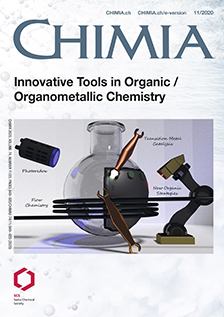N-Heterocyclic Carbene Triazolium Salts Containing Brominated Aromatic Motifs: Features and Synthetic Protocol
DOI:
https://doi.org/10.2533/chimia.2020.878PMID:
33243323Keywords:
Arylhydrazine, De-silylation, Nhc, Organocatalysis, Triazolium saltsAbstract
In this work, we provide a brief overview of the role of N-aryl substituents on triazolium N-heterocyclic carbene (NHC) catalysis. This synopsis provides context for the disclosed synthetic protocol for new chiral N-heterocyclic carbene (NHC) triazolium salts with brominated aromatic motifs. Incorporating brominated aryl rings into NHC structures is challenging, probably due to the substantial steric and electronic influence these substituents exert throughout the synthetic protocol. However, these exact characteristics make it an interesting N-aryl substituent, because the electronic and steric diversity it offers could find broad use in organometallic- and organo-catalysis. Following the synthetic reaction by NMR guided the extensive modification of a known protocol to enable the preparation of these challenging NHC pre-catalysts.
Downloads
Published
Issue
Section
License
Copyright (c) 2020 Anas Abo Raed, Vasudevan Dhayalan, Shahar Barkai, Anat Milo

This work is licensed under a Creative Commons Attribution-NonCommercial 4.0 International License.







